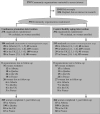Long-term effect of community-based continence promotion on urinary symptoms, falls and healthy active life expectancy among older women: cluster randomised trial
- PMID: 31220200
- PMCID: PMC6593322
- DOI: 10.1093/ageing/afz038
Long-term effect of community-based continence promotion on urinary symptoms, falls and healthy active life expectancy among older women: cluster randomised trial
Abstract
Background: The long-term effectiveness of group continence promotion delivered via community organisations on female urinary incontinence, falls and healthy life expectancy remains unknown.
Methods: A pragmatic cluster randomised trial was conducted among 909 women aged 65-98 years with urinary incontinence, recruited from 377 community organisations in the UK, Canada and France. A total of 184 organisations were randomised to an in-person 60-min incontinence self-management workshop (461 participants), and 193 to a control healthy ageing workshop (448 participants). The primary outcome was self-reported incontinence improvement at 1-year. Falls and gains in health utility were secondary outcomes.
Results: A total 751 women, mean age 78.0, age range 65-98 completed the trial (83%). At 1-year, 15% of the intervention group versus 6.9% of controls reported significant improvements in urinary symptoms, (difference 8.1%, 95% confidence intervals (CI) 4.0-12.1%, intracluster correlation 0.04, number-needed-to-treat 13) and 35% versus 19% reported any improvement (risk difference 16.0%, 95% CI 10.4-21.5, number-needed-to-treat 6). The proportion of fallers decreased from 42% to 36% in the intervention group (-8.0%, 95% CI -14.8 - -1.0) and from 44% to 34% in the control group (-10.3%, 95% CI -17.4 - -3.6), no difference between groups. Both intervention and control groups experienced a gain in health utility (0.022 points (95% CI 0.005-0.04) versus 0.035 (95% CI 0.017-0.052), respectively), with no significant difference between groups.
Conclusion: Community-based group continence promotion achieves long-term benefits on older women's urinary symptoms, without improvement in falls or healthy life expectancy compared with participation in a healthy ageing workshop.
Keywords: cluster randomised trial; falls; health utility; older people; older women; urinary incontinence.
© The Author(s) 2019. Published by Oxford University Press on behalf of the British Geriatrics Society.
Figures
Comment in
-
Re: Long-Term Effect of Community-Based Continence Promotion on Urinary Symptoms, Falls and Health Active Life Expectance among Older Women: Cluster Randomised Trial.J Urol. 2020 Oct;204(4):856-857. doi: 10.1097/JU.0000000000001207.01. Epub 2020 Jul 23. J Urol. 2020. PMID: 32702255 No abstract available.
References
-
- News From the Centers for Disease Control and Prevention US toll from incontinence. JAMA 2014; 312: 884–884.
-
- Geyer G. Establishing the European Research Area in Ageing: a network of national research programmes. Exp Gerontol 2005; 40: 759–62. - PubMed
Publication types
MeSH terms
LinkOut - more resources
Full Text Sources
Medical



